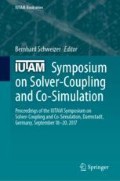Abstract
In this paper, an approach for controlling the communication-step size in connection with explicit co-simulation methods is suggested. In the framework of the proposed communication-step size controller, each subsystem integration is carried out with two different explicit co-simulation methods. By comparing the variables for both integrations, an error estimator for the local error can be constructed. Making use of the estimated local error, a step-size controller for the communication step-size can be implemented. Examples are presented demonstrating the applicability and accuracy of the proposed communication-step size controller.
Access this chapter
Tax calculation will be finalised at checkout
Purchases are for personal use only
References
Eich-Soellner, E., Führer, C.: Numerical Methods in Multibody Dynamics, vol. 45. Teubner, Stuttgart (1998)
Gomes, C., et al.: Co-simulation: state of the art. arXiv:1702.00686 (2017)
Gustafsson, K., Lundh, M., Söderlind, G.: API stepsize control for the numerical solution of ordinary differential equations. BIT Numer. Math. 28(2), 270–287 (1988)
Kübler, R., Schiehlen, W.: Two Methods of Simulator Coupling. Math. Comput. Model. Dyn. Syst. 6(2), 93–113 (2000)
Meyer, T., Li, P., Lu, D., Schweizer, B.: Implicit co-simulation method for constraint coupling with improved stability behavior. Multibody Syst. Dyn. 1–27 (2018)
Milne, W. E.: Numerical integration of ordinary differential equations. Am. Math. Mon. 33(9), 455–460 (1926)
Schweizer, B., Li, P., Lu, D.: Explicit and implicit cosimulation methods: stability and convergence analysis for different solver coupling approaches. J. Comput. Nonlinear Dyn. 10(5), 051007 (2015)
Author information
Authors and Affiliations
Corresponding author
Editor information
Editors and Affiliations
Appendix: Alternative Co-simulation Approach with Improved Convergence Order
Appendix: Alternative Co-simulation Approach with Improved Convergence Order
In Sect. 11.5.2, we have seen, that the local error of the position variables converges with order \(k+3\). However, the velocity variables converge only with order \(k+2\), which causes that the global error converges only with order \(k+1\). Combining the two methods described in Sect. 11.4 yields an alternative method (method 3), which may increase the convergence order of the local error of the velocity variables. Thus, the local error may converge with order \(k+3\) and consequently the global error may converge with order \(k+2\). We define the new polynomial
where \(\alpha \) is an arbitrary real number. For analyzing the consistency, we define
We have
With the constants
and with Eqs. (11.41) and (11.42), we obtain
which vanishes for \(\alpha = \frac{D^{k+1}_{N+1}}{D^k_{N+1}}\). Together with Eq. (11.56), we get
Figure 11.15 shows the convergence of the local error on position and velocity level for method 3. The convergence plots confirm that the local error converges with order \(k+3\) on position and on velocity level. As expected, the global error converges with order \(k+2\), which can be seen in Fig. 11.16. To derive an error estimator, it seems straightforward to use method 1 as reference. Then, the error is estimated by
where \(\mathbf {q}_{N+1}^\alpha \) is the numerical solution of the position variables of the simulations carried out with the polynomials \(\mathbf {p}_{N+1}^\alpha \!\left( t\right) \). Unfortunately, the local error is too badly estimated, if the predicted values \(\mathbf {u}_{N+1}^{\mathrm {pre}}\) (see Sect. 11.4.2) are computed with only \(k+2\) sampling points. A similar problem was already mentioned in Remark 11.2 (Sect. 11.7.2). Figure 11.17 shows the local error and the estimated local error. The simulations have been carried out with quadratic approximation polynomials (\(k=2\)). The predicted coupling values are extrapolated with four supporting points.
To improve the error estimator, method 3 is modified by increasing the extrapolation order for calculating the predicted coupling values. As can be seen in Fig. 11.18, the error estimator is improved, if the predicted values are extrapolated by five sampling point.
Rights and permissions
Copyright information
© 2019 Springer Nature Switzerland AG
About this paper
Cite this paper
Meyer, T., Kraft, J., Lu, D., Schweizer, B. (2019). Error Estimation Approach for Controlling the Communication Step-Size for Explicit Co-simulation Methods. In: Schweizer, B. (eds) IUTAM Symposium on Solver-Coupling and Co-Simulation. IUTAM Bookseries, vol 35. Springer, Cham. https://doi.org/10.1007/978-3-030-14883-6_11
Download citation
DOI: https://doi.org/10.1007/978-3-030-14883-6_11
Published:
Publisher Name: Springer, Cham
Print ISBN: 978-3-030-14882-9
Online ISBN: 978-3-030-14883-6
eBook Packages: EngineeringEngineering (R0)





